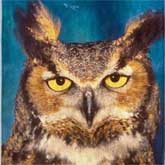Wise As An Owl
 Are owls the smartest birds? According to trainers that work with them, not by a long shot. Parrots are easy to train and can have extensive vocabularies. Hawks can be taught to retrieve objects. Even pigeons are used in behavioral studies and can be conditioned to obtain a reward by carrying out certain actions. But most species of owls can't be trained to do even the most rudimentary tasks. So why do we have the expression 'wise as an owl'? The most common answer - they look smart. And what makes them look so smart? It's their eyes. An owl's eyes are enormous compared the size of its head. In humans, large pupils are equated with focusing and attention being paid. An owl's large, dark eyes make it look like it is paying attention. Its eyes are also fixed in its head. In order for an owl to move its eyes, it must move the whole head. It gives an owl a intelligent gaze as it scans the surroundings.
Are owls the smartest birds? According to trainers that work with them, not by a long shot. Parrots are easy to train and can have extensive vocabularies. Hawks can be taught to retrieve objects. Even pigeons are used in behavioral studies and can be conditioned to obtain a reward by carrying out certain actions. But most species of owls can't be trained to do even the most rudimentary tasks. So why do we have the expression 'wise as an owl'? The most common answer - they look smart. And what makes them look so smart? It's their eyes. An owl's eyes are enormous compared the size of its head. In humans, large pupils are equated with focusing and attention being paid. An owl's large, dark eyes make it look like it is paying attention. Its eyes are also fixed in its head. In order for an owl to move its eyes, it must move the whole head. It gives an owl a intelligent gaze as it scans the surroundings.
Just how big an owl's eyes are compared to its body may surprise you. For example, the horned owl, native to North America, can grow to a height of around two feet. That's a good-sized bird. At that size you might guess that it weighs easily over ten lbs. A house cat sitting at half that height weighs about ten lbs. But the horned owl would tip the scales at no more than three lbs. They are truly light as a feather. And that is a good analogy. An owl's feathers give us a false impression of its true size. Take its feathers away and an owl is a very small bird. If you touched the top of a horned owl's head, your finger would go through two inches of feathers before making contact with its skin. But returning to those eyes, an owl's eyes are even bigger than they look. Take away all those feathers and an owl's eyes are hugh. If our eyes were proportionally as big as an owl's eyes, they'd be larger than oranges.
And therein lies the truth. An owl may be impossible to train, but that doesn't mean that there is not a lot of processing going on in its brain. Owls are master hunters. They easily boast a kill rate of over 85%. That's better by far than hawks and other raptors. A large factor in making them such effective hunters is those eyes. An owl has extraordinary night vision and unmatched peripheral vision, while at the same time maintaining excellent daytime vision. An owl can even control the amount of light entering its eyes independently, by enlarging either its left or right pupil to compensate for shadows. What this ultimately means is that the owl's brain spends much of its time processing information from its optic nerves. In fact, neurological maps of an owl's functioning brain reveal an extensive amount of brain power focused on their sense of sight. Owls may not be trainable, but that doesn't mean that there is not a lot going on in their brains. They are busy taking it all in.
About the Author
Gene Mascoli, JD
 Gene Mascoli is a founder and publisher of ScienceIQ.com. He holds a J.D. degree from the University of Santa Clara and a B.A. in English. In 1997 Gene launched ScienceMaster.com, an online science education portal where he brought together his love of writing with his interest in the sciences. Gene collaborated with David Gamon on the popular digital book
“The Internet Guide to NASA on the Net” and has also produced two popular science CD-ROMs on astronomy and space science.
Gene Mascoli is a founder and publisher of ScienceIQ.com. He holds a J.D. degree from the University of Santa Clara and a B.A. in English. In 1997 Gene launched ScienceMaster.com, an online science education portal where he brought together his love of writing with his interest in the sciences. Gene collaborated with David Gamon on the popular digital book
“The Internet Guide to NASA on the Net” and has also produced two popular science CD-ROMs on astronomy and space science.


